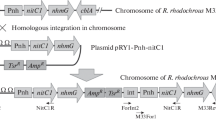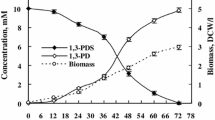Abstract
As the third-generation biocatalyst for industrial production of acrylamide, the superiority of Rhodococcus rhodochrous J1 nitrile hydratase was demonstrated in comparison with other acrylamide-producing bacteria. R. rhodochrous J1 enzyme is much more heat stable and more tolerant to a high concentration of acrylonitrile than Pseudomonas chlororaphis B23 and Brevibacterium R312 enzymes. The J1 enzyme is peculiar in its extremely high tolerance to acrylamide. The hydration reaction of acrylonitrile catalysed by J1 cells proceeded even in the presence of 50% (w/v) acrylamide. The tolerance of J1 enzyme to various organic solvents such as n-propanol and isopropanol was prominent. Using R. rhodochrous J1 resting cells, the accumulation reaction was carried out by feeding acrylonitrile to maintain a level of 6%. After 10 h incubation, the accumulation of acrylamide was approximately 65.6% (w/v) at 10°C, 56.7% (w/v) at 15°C, and 56.0 (w/v) at 20°C. The high stability, high catalytic efficiency and other outstanding features of the J1 enzyme are analysed and discussed.
Similar content being viewed by others
References
Asano Y, Fujishiro K, Tani Y, Yamada H (1982a) Aliphatic nitrile hydratase from Arthrobacter sp. J-1; purification and characterization. Agric Biol Chem 46:1165–1174
Asano Y, Yasuda Y, Tani Y, Yamada H (1982b) A new enzymatic method of acrylamide production. Agric Biol Chem 46:1183–1189
Bandyopadhyay AK, Nagasawa T, Asano Y, Fujishiro K, Tani Y, Yamada H (1986) Purification and characterization of benzonitrilases from Arthrobacter sp. strain J-1. Appl Environ Microbiol 56:302–306
Bradford MM (1976) A rapid and sensitive method for the quantitation of microgram quantities of protein utilizing the principle of protein-dye binding. Anal Biochem 72:248–254
Commeyras A, Arnaud A, Galzy P, Jallageas JL (1976) Manufacturing of amides through biological hydrolysis. Japanese patent publication 51-86186
Commeyras A, Arnaud A, Galzy P, Jallageas JL (1983) Manufacturing of organic acids through biological hydrolysis Japanese laid-open patent publication 58-15120
Endo T, Watanabe I (1989) Nitrile hydratase of Rhodococcus sp. N-774: purification and amino acid sequences. FEBS Lett 243:61–64
Goldlust A, Bohak Z (1989) Induction, purification, and characterization of the nitrilase of Fusarium oxysporum f. sp. melonis. Biotechnol Appl Biochem 11:581–601
Harper DB (1977a) Microbial metabolism of aromatic nitriles. Biochem J 165:309–319
Harper DB (1977b) Fungal degradation of aromatic nitriles. Biochem J 165:685–692
Harper DB (1985) Characterization of a nitrilase from Nocardia sp. (Rhodochrous group) N.C.I.B. 11215, using p-hydroxybenzonitrile as sole carbon sourse. Int J Biochem 17:677–683
Ikehata O, Nishiyama M, Horinouchi S, Beppu T (1989) Primary structure of nitrile hydratase deduced from the nucleotide sequence of a Rhodococcus species and its expression in Escherichia coli. Eur J Biochem 181:563–570
Kobayashi M, Nagasawa T, Yamada H (1989) Nitrilase of Rhodococcus rhodochrous J1: Purification and characterization. Eur J Biochem 182:349–356
Kobayashi M, Yanaka N, Nagasawa T, Yamada H (1990) Purification and characterization of a novel nitrilase of Rhodococcus rhodochrous K22 that acts on aliphatic nitriles. J Bacteriol 172:4807–4815
Kobayashi M, Nishiyama M, Nagasawa T, Horinouchi S, Beppu T, Yamada H (1991) Cloning, nucleotide sequence and expression in Escherichia coli of two cobalt-containing nitrile hydratase genes from Rhodococcus rhodochrous J1. Biochim Biophys Acta 1129:23–33
Mauger J, Nagasawa T, Yamada H (1988) Nitrile hydratase-catalyzed production of isonicotinamide, picolinamide and pyrazinamide from 4-cyanopyridine, 2-cyanopyridine and cynopyrazine in Rhodococcus rhodochrous J1. J Biotechnol 8:87–96
Mauger J, Nagasawa T, Yamada H (1989) Synthesis of various aromatic derivatives using nitrile hydratase of Rhodococcus rhodochrous J1. Tetrahedron 45:1347–1356
Mayaux J-F, Cerbelaud E, Soubrier F, Faucher D, Petre D (1990) Purification, cloning, and primary structure of an enantiomer-selective amidase from Brevibacterium sp. strain R312: structural evidence for genetic coupling with nitrile hydratase. J Bacteriol 172:6764–6773
Nagasawa T, Yamada H (1989) Microbial transformations of nitriles. Trends Biotechnol 7:153–158
Nagasawa T, Yamada H (1993) Microbial production of commodity chemicals. Pure Appl Chem (in press)
Nagasawa T, Ryuno K, Yamada H (1986) Nitrile hydratase of Brevibacterium R312: purification and characterization. Biochem Biophys Res Commun 139:1305–1312
Nagasawa T, Nanba H, Ryuno K, Takeuchi K, Yamada H (1987) Nitrile hydratase of Pseudomonas chlororaphis B23: Purification and characterization. Eur J Biochem 162:691–698
Nagasawa T, Mathew CD, Mauger J, Yamada H (1988a) Nitrile hydratase-catalyzed production of nicotinamide from 3-cyanopyridine in Rhodococcus rhodochrous J1. Appl Environ Microbiol 54:1766–1769
Nagasawa T, Takeuchi K, Yamada H (1988b) Occurrence of a cobalt-induced and cobalt-containing nitrile hydratase in Rhodococcus rhodochrous J1. Biochem Biophys Res Commun 155:1008–1016
Nagasawa T, Ryuno K, Yamada H (1989) Superiority of Pseudomonas chlororaphis B23 nitrile hydratase as a catalyst for the enzymatic production of acrylamide. Experimentia 45:1066–1070
Nagasawa T, Mauger J, Yamada H (1990) A novel nitrilase, arylacetonitrilase, of Alcaligenes faecalis JM3: purification and characterization. Eur J Biochem 194:765–772
Nagasawa T, Takeuchi K, Nardi-Dei V, Mihara Y, Yamada H (1991a) Optimum culture conditions for the production of cobalt-containing nitrile hydratase by Rhodococcus rhodochrous J1. Appl Microbiol Biotechnol 34:783–788
Nagasawa T, Takeuchi K, Yamada H (1991b) Characterization of a new cobalt-containing nitrile hydratase purified from urea-induced cells of Rhodococcus rhodochrous J1. Eur J Biochem 196:581–689
Nakai K, Watanabe I, Sato T, Enomoto K (1988) Development of acrylamide manufacturing process using microorganism. Nippon Nogeikagaku Kaishi 62:1443–1450
Nishiyama M, Horinouchi S, Kobayashi M, Nagasawa T, Yamada H, Beppu T (1991) Cloning and characterization of genes responsible for metabolism of nitrile compounds from Pseudomonas chlororaphis B23. J Bacteriol 173:2465–2472
Stellwagen E, Wilgus H (1978) Relationship of protein thermostability to accessible surface area. Nature 275:343–343
Sugiura Y, Kuwahara J, Nagasawa T, Yamada H (1987) Nitrile hydratase: the first non-heme iron enzyme with a typical lowspin Fe (III) active center. J Am Chem Soc 109:5848–5850
Watanabe I, Satoh Y, Enomoto K (1987a) Screening, isolation and taxonomical properties of microorganisms having acrylonitrile-hydrating activity. Agric Biol Chem 51:3193–3199
Watanabe I, Satoh Y, Enomoto K, Seki S, Sakashita K (1987b) Optimal conditions for cultivation of Rhodococcus sp. N-774 and for conversion of acrylonitrile to acrylamide by resting cells. Agric Biol Chem 51:3201–3206
Yamada H, Ryuno K, Nagasawa T, Enomoto K, Watanabe I (1986) Optimum culture conditions for production by Pseudomonas chlororaphis B23 of nitrile hydratase. Agric Biol Chem 50:2859–2865
Yamamoto K, Komatsu K (1991) Purification and characterization of nitrilase responsible for the enantioselective hydrolysis from Acinetobacter sp. AK226. Agric Biol Chem 55:1459–1466
Author information
Authors and Affiliations
Additional information
Correspondence to: T. Nagasawa
Rights and permissions
About this article
Cite this article
Nagasawa, T., Shimizu, H. & Yamada, H. The superiority of the third-generation catalyst, Rhodococcus rhodochrous J1 nitrile hydratase, for industrial production of acrylamide. Appl Microbiol Biotechnol 40, 189–195 (1993). https://doi.org/10.1007/BF00170364
Received:
Revised:
Accepted:
Issue Date:
DOI: https://doi.org/10.1007/BF00170364




